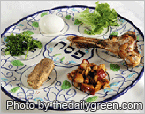One of the most important parts of the Passover Seder is the Seder Plate. It contains six foods, each a symbol that is significant in the retelling of the story of the exodus from Egypt. There is a seventh symbolic food as well (a stack of three matzo), but it has its own plate on the Seder table.
The Seder PlateThe six items of the Passover Seder Plate are arranged in a circle on the Seder plate. Here they are, starting at the top and going clockwise:

Photo by thedailygreen.com
- Chazeret - This is a bitter herb that symbolizes the harshness that the Jews endured while slaves in Egypt. For chazeret, most people use romaine lettuce because its roots have a bitter taste.
- Z'roa - Z'roa is a roasted lamb or goat shank bone, a chicken wing, or a chicken neck. It symbolizes the korban Pesach, which was the sacrificial lamb, offered in the Temple of Jerusalem. After being sacrificed, it would be eaten as part of the meal on Seder night.
- Charoset - Used to represent the mortar the Jews used to build storehouses for the Egyptians, charoset is a sweet, brown mixture made from chopped nuts, sweet red wine, cinnamon, and grated apples. Sephardi Jews traditionally add dates and honey to the mixture. The ingredients here reflect the foods that King Solomon compared Israel to in his Song of Songs.
- Maror - Maror is another bitter herb that symbolizes the bitterness of the Jew's enslavement. Many people, for maror, combine grated horseradish with cooked beets and sugar to make a condiment named cherin. Another option is to eat whole horseradish root, while Jews of the Sepharadic tradition use curled parsley dipped in vinegar or saltwater.
- Karpas - This vegetable, usually parsley, celery, or boiled potato, is dipped into salt water at the beginning of the Passover Seder. The saltwater represents tears, while the karpas as a whole is supposed to mirror the pain of Jewish slaves in Egypt, who could only eat simple foods. Since vegetables are not usually the first thing to be eaten during a Jewish holiday meal, the act of eating karpas so early in the Passover Seder is designed to cause the children at the table to ask questions. This leads to the next part of the meal, which is the recitation of the question, Ma Nishtana: "Why is this night different from all other nights?"
- Beitzah - Simply a hardboiled egg, the beitzah is a representation of the korban chagigah, the festival sacrifice offered in the Temple of Jerusalem. Like the z'roa, it would be roasted and eaten as part of the meal on Seder night. The egg is a symbol of mourning, meant to be reflective of mourning over the destruction of the temple and the subsequent inability to offer sacrifices there. The beitzah serves as a visual reminder only and has no formal use during the Passover Seder. Oftentimes, though, it is eaten with saltwater as the first course of the meal.
Each of these items has a role to play in the ritual of the Passover Seder. They serve as reminders of what the Jewish people went through during their enslavement and eventual exodus from Egypt, and they help those in attendance to, in a way, relive those events.